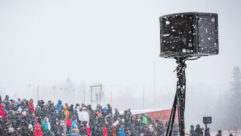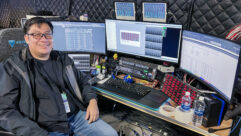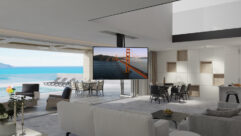
Installation Profile:
Spreading the Word
Jan 1, 2005 12:00 PM,
By Gary Eskow
An upgraded, state-of-the-art video production, postproduction, and webcasting facility ensures that Trinity Church’s ministry extends well beyond its walls.
Photo: Leo Sorel
Although it is undoubtedly true that the horrors of 9/11 touched all Americans, it is equally true that those at the epicenter of the events were transformed in special ways. Trinity Church, New York City, stands on Wall Street in lower Manhattan, directly across from the site where the World Trade towers once stood. Founded in 1697, the church has played an active role in New York City life throughout its history. In addition to the 18 weekly worship services its staff conducts, Trinity Church is active in assisting a variety of outside constituencies, including the homeless, and has a well-respected concert series that attracts high-quality artists and music lovers.
As involved as Trinity Church had been in the social life of the community it serves, the shattering impact of 9/11 mandated a renewed, altered sense of purpose for everyone, including the staff at Trinity Church Television and New Media. Sensing a new opportunity to help in the healing process that lower Manhattan needed, Bert Medley, director of the department, with the church administration’s support, set out to expand and revitalize the media production center to accommodate an increase in news and documentary programming. A special emphasis was put on using the Internet to make video and audio copies of sermons and other events available to those who could not attend in person.
Medley spent 35 years in the production department at NBC. A member of the Vestry — the board of directors at Trinity Church Wall Street — Medley retired from NBC following 9/11, accepted his current position, and set out to change the business model of the production department.

Dean Wiltshire, streaming technician, and Lenny Manchess, audio engineer, at work on a Sunday morning service at New York City’s Trinity Church.
“My background was in news and documentaries,” he says. “After the attack it was clear that we needed to respond to the needs of the community and develop content that centered around 9/11.”
One of the church’s facilities, the St. Paul Chapel, is the oldest continually used public building in Manhattan. Built in 1766, it became a place of respite for the rescue and recovery workers in the wake of the 9/11 tragedy. From that experience, Trinity Church derived a wealth of content. The church soon realized that with the increased production of 9/11 documentaries and the active role it wanted to play in the overall healing process, it would be performing significantly more video editing than ever before.
Further, much of the church’s production and postproduction gear was damaged because of the dust that filled the facility when the towers collapsed. The church staff decided to purchase new equipment and upgrade its rooms to allow them to handle the increased workflow and changed the focus of their work. That posed no insignificant challenge. The department, active for almost 30 years, was originally founded to provide content (primarily church services) for local cable access channels. Eventually, it grew to become the foundation for the Hallmark Channel, providing a variety of content for cable, satellite distribution, and eventually the Internet. In addition to the services the department continued to broadcast, it developed other content, including documentaries and interviews.
The church also hired Barry Glasser, who had been working at the Freedom Forum and had, prior to that, built two other organizations: Court TV and Reuters Financial Television.
“Barry is a perfect person for us to have,” Medley says. “When we set about rebuilding the organization, and looked at ways to make it more streamlined, we had a three-camera digital studio, a separate edit room, some Beta machines, and [some] DVCPRO [gear]. We embarked on a path to integrate all of these assets into a single, cohesive system.”
The Trinity Church Television & New Media production facility has grown considerably in the last several years. The department has made a commitment to nonlinear editing, and it currently counts among its gear an Avid Symphony, Final Cut Pro 4, a pair of Avid Xpress DV workstations, and a Sony BVE-2000 linear editing system. Ultimately, it went from a single digital control room with a lone Ross switcher to a pair of digital control rooms. The team focused on how it could gather assets from its various sources and collect them in a single location, thereby allowing them to move the elements digitally. The church purchased an Omneon Spectrum Media Server, which Medley considers a worthy addition to the suite of rooms.
Control Room A has a Ross Synergy2, with two mix effects busses, built-in DVE (digital video effects), and Ultimatte. The board takes in 32 channels of video data, layered on a pair of buss lines that have 16 inputs. The Synergy 2 is primarily dedicated to controlling the production facility’s three-camera (Sony BVP E10) digital studio.
Studio A, connected to the rest of the facility via a Leitch digital router, also has an ETC digital board (which can store scene settings on the board and save shows to disk) and a number of different tape decks. “We’ve got a pair of Sony [Digital Betacams],” says Medley, “a Sony DVCAM, three standard Beta SP analog decks, and our latest acquisition: the Pioneer digital DVD recorder, PRV-LX1. The Pioneer deck lets you author DVD content in a separate hardware device instead of software, and that brings two advantages. One, there’s a lower learning curve; and two, the platform is stable. The PRV-LX1 has two DVD drives and a 120GB hard drive, and it can input graphics. We also use [a] Panasonic DVCPRO [camera and four decks], the first digital format that we went with. In essence we’re a full-service facility and can operate on almost any tape format, including 1in.”

Trinity Church’s website (www.trinitywallstreet.org) provides links to all live and on-demand webcasts.
Trinity Church Television & New Media also has a fiber link connection to Waterfront (now known as Ascent Media), a Manhattan-based fiber port. Medley considers the link extremely important for programming. Instead of having crews in the church itself, the staff simply sends a feed to the fiber port, where other clients — Reuters, BBC, and local television stations, for example — can pick it up.
The church also has a second control room primarily used for webcasting. Both control rooms are connected with the Trinity Church (a separate building across the street) by internal Telecast fiber networks and separate triax networks. The staff can control the studio cameras from Control Room 2 as well. The room has a smaller Ross Synergy 100 digital switcher with 16 inputs on two busses. The switcher’s main purpose is to stream Sunday services and other events conducted at Trinity Church. Control Room 2 is also used to control four Sony DXC-990 three-chip color cameras with Fujinon robotics and teleconferencing lenses. There is also a Mackie 32×8×2 analog mixing console that receives house audio and 12 independent channels of ambient audio. Switcher output runs to a Pinnacle StreamFactory 2 and then to the streaming provider, Speedera. The staff uses this control room to stream the 11:15 a.m. Sunday service, which is streamed live and then archived on the Web. These services are available on demand at www.trinitywallstreet.org.
Medley and his staff rely heavily on robotics for the broadcasts of their services. Utilizing a combination of four Sony DXC-990 cameras and Fujinon teleconferencing lenses in place of a live crew, a single staff member serving as a cross between a director and technical director decides which camera will be online at any given moment. If necessary, the department can transport the six additional cameras they own to the church and integrate them into a production. “We’re in a different building, separated from the church by a pedestrian bridge,” says Medley. “We have a Fujinon control panel that lets us control all of our cameras. The only production crew we have is in our streaming control room, and we maintain separate control for webcasting and broadcasting. We can actually run two separate events at one time if we need to.”

Monitoring audio during a special lecture series webcast.
As a matter of course the church avoids IMAG during services. Forums and conferences do require plasma screens on occasion, which are rented on an as-needed basis. “We treat the services as a service and don’t add any production value to them or the concerts we broadcast,” says Medley. “We do add production value to our documentaries, particularly on the opens and closes.
Alongside the director/TD sits an audio mixer and a third person in the streaming area, who is responsible for making sure that the encoded material successfully makes its way out of the system and to Speedera. This operator is also responsible for recording the switched feeds onto the Avid Xpress DV systems. This same material is later edited for broadcast or webcast, if the staff decides to excerpt from it. For example, on November 16, Trinity Church aired a forum that focused on the issues of values and rhetoric surrounding the presidential election, moderated by Jim Wallis of Sojourners magazine. Panelists included: leading conservative evangelical Dr. Richard Land of the Southern Baptist Convention; the Reverend Bryan Hehir, a Catholic priest at Harvard’s John F. Kennedy School of Government; and the Reverend Jim Forbes, a senior minister of the Riverside Church in New York. That event, which has drawn some interest from PBS, used six cameras and had some production value added to it.

The control during the webcast of Trinity Institute lecture series. For special webcasts, additional cameras supplement the four permanent robotic cameras.
The Omneon server offers the staff another place to park material for later use, but it isn’t used as much for webserving. During forums, for example, the staff might store some of the closeup camera footage there and then return to it. If they choose to use it, they will pull it back out and drop it into the Avid Symphony. The Omneon functions like several connected tape machines. The staff can record and play back from many different sources, drag files across digitally, and place them in one of the various Symphony and Final Cut Pro 4 editing systems.
“We also stream concerts, which are held on weekdays and Sunday afternoons and recorded for broadcast on WQXR, the local Classical music station,” Medley says. “We’ve used streaming technology to build an online congregation. We have several people throughout the world who regularly watch the webcasts and comment to us on them. They’re not bashful about letting us know if we’ve made a mistake, and if they’re enjoying what they’re seeing. They visit us for either the liturgy, or the music, or for a sense of community. We also provide some special programming — forums, for example — which also get archived. This is our way of reaching out to another, much broader, congregation.”
Trinity Church has also entered into the realm of DVD production. Control Room 2 has a pair of Avid Xpress DV systems, which the staff uses to record and edit services and produce DVDs. The also church has its own DVD manufacturing and printing operation, and DVDs are available to anyone who wants them. According to Medley, Trinity Television and Media’s new catalog will be about 60 pages long with a wide range of organization-produced offerings — interviews, forums, dramatic productions, and roundtable discussions. All programming is available in DVD and VHS, and the video catalog can be found on the website.
Medley says that webcasting has ultimately become a significant part in advancing Trinity Church’s mission in recent years. “It’s very important,” he says. “As I said, webcasting allows us to reach audiences around the world who may have no other access to the kind of liturgy that we have here. We know anecdotally that our webcasts are seen in Denmark, Germany, Great Britain, and Australia. In the U.S. we have received email from several people who have indicated that they come to our webcasts during the afternoon or weekday to share them with shut-ins. We now also provide spiritual content for the Microsoft Network, MSN.com, which lets us reach a totally different audience; again, one that might not have had access to the kind of spiritual content we provide.”
For More Information
Ascent Media Network Services
www.ascentmedia.com
Avid Technology
www.avid.com
Apple (Final Cut Pro)
www.apple.com
Fujinon
www.fujinon.com
Leitch
www.leitch.com
Mackie
www.mackie.com
Omneon
www.omneon.com
Panasonic
www.panasonic.com
Pioneer Electronics
www.pioneerelectronics.com
Pinnacle Systems
www.pinnaclesys.com
Ross Video
www.rossvideo.com
Sony Electronics
www.sony.com
Speedera
www.speedera.com










